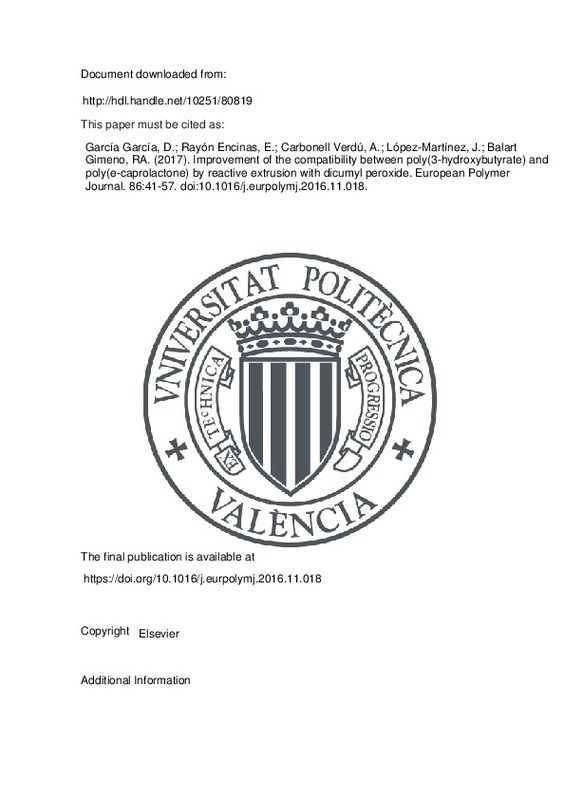JavaScript is disabled for your browser. Some features of this site may not work without it.
Buscar en RiuNet
Listar
Mi cuenta
Estadísticas
Ayuda RiuNet
Admin. UPV
Improvement of the compatibility between poly(3-hydroxybutyrate) and poly(e-caprolactone) by reactive extrusion with dicumyl peroxide
Mostrar el registro sencillo del ítem
Ficheros en el ítem
| dc.contributor.author | García García, Daniel
|
es_ES |
| dc.contributor.author | Rayón Encinas, Emilio
|
es_ES |
| dc.contributor.author | Carbonell Verdú, Alfredo
|
es_ES |
| dc.contributor.author | López-Martínez, Juan
|
es_ES |
| dc.contributor.author | Balart Gimeno, Rafael Antonio
|
es_ES |
| dc.date.accessioned | 2017-05-10T12:14:13Z | |
| dc.date.available | 2017-05-10T12:14:13Z | |
| dc.date.issued | 2017-01 | |
| dc.identifier.issn | 0014-3057 | |
| dc.identifier.uri | http://hdl.handle.net/10251/80819 | |
| dc.description.abstract | [EN] Poly(3-hydroxybutyrate) is a biodegradable aliphatic polyester obtained through bacterial fermentation that has gained attention in the last few years; nevertheless, its industrial applications are restricted because of some drawbacks related to its high stiffness and fragility which is associated to its high crystallinity. In this work, poly(3-hydroxybutyrate) (P3HB) was melt blended with poly(e-caprolactone) (PCL) at a constant weight ratio of 75/25 (P3HB/PCL) by reactive extrusion with different contents of dicumyl peroxide (DCP) in the 0 1 wt% range. The effects of the DCP load on mechanical, thermal and morphology of the P3HB/PCL blend were studied. Results showed a positive increase in the elongation at break and the impact-absorbed energy of 91% and 231% respectively with regard the uncompatibilized P3HB/PCL blend by the addition of 1 wt% DCP, being this a clear evidenced of the improved compatibility between these polymers. Moreover, morphology of DCP-compatibilized P3HB/PCL blend obtained by field emission electron microscopy (FESEM) and atomic force microscopy (AFM) showed a remarkable decrease in the particle size of poly(e-caprolactone)-rich domains randomly dispersed in the poly(3-hydroxybutyrate). In addition, both FESEM and AFM also revealed improved interfacial adhesion between P3HB- and PCL-rich phases with a noticeable decrease in the gap between them. Addition of 1 wt% DCP also contributes to lowering the degree of crystallinity of PHB by 14% in the blend and other thermal properties are not highly affected by the reactive extrusion with DCP. ©2016 Elsevier Ltd. All rights reserved. | es_ES |
| dc.description.sponsorship | This research was supported by the Ministry of Economy and Competitiveness MINECO through the grant number MAT2014-59242-C2-1-R. D. Garcia-Garcia wants to thank the Spanish Ministry of Education, Culture and Sports for the financial support through a FPU grant number FPU13/06011. A. Carbonell-Verdu acknowledges Universitat Politecnica de Valencia for financial support through an FPI grant. | en_EN |
| dc.language | Inglés | es_ES |
| dc.publisher | Elsevier | es_ES |
| dc.relation.ispartof | European Polymer Journal | es_ES |
| dc.rights | Reserva de todos los derechos | es_ES |
| dc.subject | Poly(3-hydroxybutyrate) | es_ES |
| dc.subject | Poly(e-caprolactone) | es_ES |
| dc.subject | Dicumyl peroxide | es_ES |
| dc.subject | Reactive compatibilization | es_ES |
| dc.subject | Blends | es_ES |
| dc.subject.classification | CIENCIA DE LOS MATERIALES E INGENIERIA METALURGICA | es_ES |
| dc.title | Improvement of the compatibility between poly(3-hydroxybutyrate) and poly(e-caprolactone) by reactive extrusion with dicumyl peroxide | es_ES |
| dc.type | Artículo | es_ES |
| dc.identifier.doi | 10.1016/j.eurpolymj.2016.11.018 | |
| dc.relation.projectID | info:eu-repo/grantAgreement/MINECO//MAT2014-59242-C2-1-R/ES/TECNICAS AVANZADAS DE PROCESADO PARA SISTEMAS ACTIVOS ENCAPSULADOS/ | es_ES |
| dc.relation.projectID | info:eu-repo/grantAgreement/MECD//FPU13%2F06011/ES/FPU13%2F06011/ | es_ES |
| dc.rights.accessRights | Abierto | es_ES |
| dc.contributor.affiliation | Universitat Politècnica de València. Instituto de Tecnología de Materiales - Institut de Tecnologia de Materials | es_ES |
| dc.contributor.affiliation | Universitat Politècnica de València. Escuela Politécnica Superior de Alcoy - Escola Politècnica Superior d'Alcoi | es_ES |
| dc.description.bibliographicCitation | García García, D.; Rayón Encinas, E.; Carbonell Verdú, A.; López-Martínez, J.; Balart Gimeno, RA. (2017). Improvement of the compatibility between poly(3-hydroxybutyrate) and poly(e-caprolactone) by reactive extrusion with dicumyl peroxide. European Polymer Journal. 86:41-57. https://doi.org/10.1016/j.eurpolymj.2016.11.018 | es_ES |
| dc.description.accrualMethod | S | es_ES |
| dc.relation.publisherversion | https://doi.org/10.1016/j.eurpolymj.2016.11.018 | es_ES |
| dc.description.upvformatpinicio | 41 | es_ES |
| dc.description.upvformatpfin | 57 | es_ES |
| dc.type.version | info:eu-repo/semantics/publishedVersion | es_ES |
| dc.description.volume | 86 | es_ES |
| dc.relation.senia | 321471 | es_ES |
| dc.contributor.funder | Ministerio de Educación, Cultura y Deporte | es_ES |
| dc.contributor.funder | Ministerio de Economía y Competitividad | es_ES |
| dc.contributor.funder | Universitat Politècnica de València | es_ES |







![[Cerrado]](/themes/UPV/images/candado.png)

